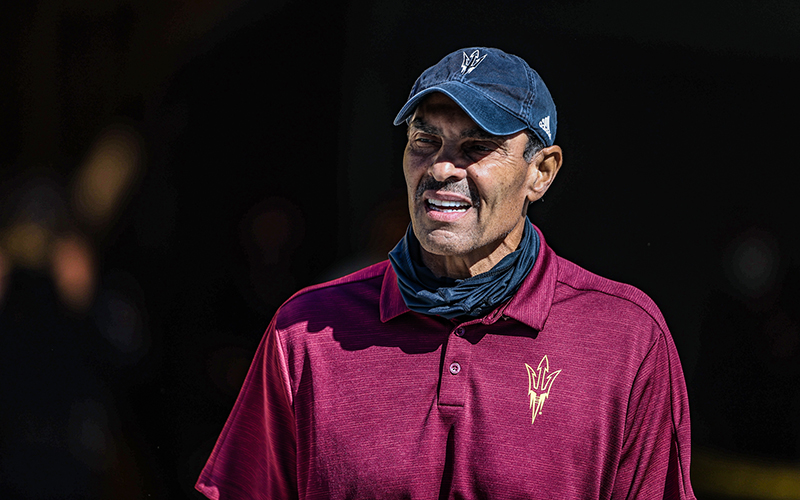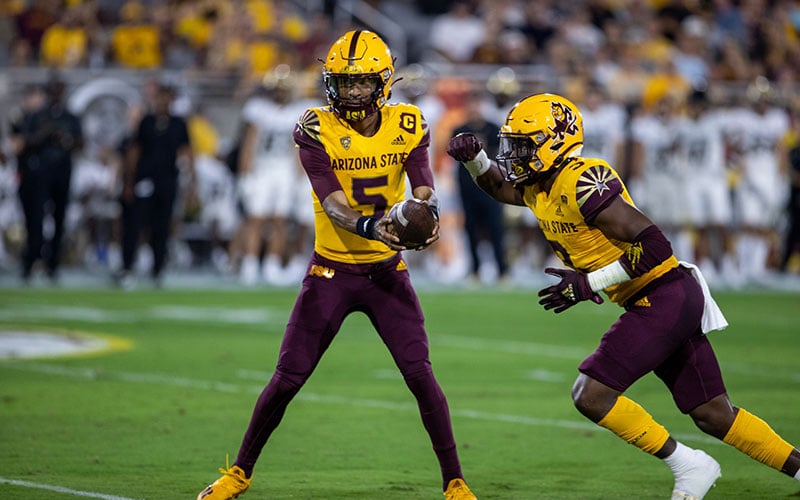
By Jack Johnson
PHOENIX – The second round of rankings by the College Football Playoff Selection Committee is set to be released Tuesday, and the Pac-12 hopes that the No. 4 Oregon Ducks did enough in a 26-16 victory over the Washington Huskies to maintain a position in the top four.
Last week’s initial poll was the first time a Pac-12 team was selected for one of the coveted top-four positions in the first week of the rankings. Previously, the highest a Pac-12 team has been ranked in the initial poll was fifth.
That was a Washington team that was 8-0 when the first ranking was released in the 2016 season, and the Huskies went on to make the four-team playoff field that season.
Oregon’s ranking is buoyed by a marquee win in Week 2, a 35-28 victory over 7-1 Ohio State. The Buckeyes have been dominating in six straight wins since. Oregon, on the other hand, lost a shocker to 3-5 Stanford four weeks ago.
However, that head-to-head win for Oregon against Ohio State carries more value than Oregon’s loss to a weaker opponent, according to the College Football Playoff Selection Committee chairman.
“They don’t have a signature win,” Iowa Athletic Director Gary Barta, who serves as chair of the committee, said of the Buckeyes. “Oregon had beaten them head-to-head. That certainly was an important criteria. Oregon had also beaten similar teams. Fresno State is 7-2 and (Oregon) won at UCLA.”
The Ducks beat Washington on the road Saturday after trailing 9-3 in the first quarter.
And the Ducks have overcome adversity throughout the season. Defensive end Kayvon Thibodeaux, the projected No. 1 overall pick in the 2022 NFL draft, and freshman linebacker Justin Flowe, the No. 6 player in the 2020 recruiting class, have missed extensive time this season. Flowe hasn’t played since Oregon’s season-opening victory over Fresno State.
Still, the Ducks have soared.
Oregon coach Mario Cristobal knows his team will experience the hype that comes with the CFP poll, but he is trying to keep it from becoming a distraction as the Ducks prepare to face Washington State Saturday.
“I don’t think it’s a matter of ignoring (it) at all,” he said. “You acknowledge it and you make sure that it’s just not part of your process. We’re in week nine and (there is) still a lot of football to be played. You can’t even look past this game. You can’t think about the other games coming down the stretch.”
One thing is certain: no other Pac-12 team needs worry about the rankings hype.
There is a precipitous and startling drop off from Oregon to the rest of the Pac-12’s teams, none of which even broke into the initial poll’s Top 25. The Pac-12 is the only Power Five conference to place just one team in the first poll.

By comparison, the non-Power Five Mountain West Conference had two teams ranked, No. 23 Fresno State and No. 24 San Diego State.
At 6-3, Utah and Arizona State are tied for the second-best record in the conference behind Oregon. Both are coming off victories Saturday with Utah beating Stanford and ASU defeating USC.
Neither appeared in the initial poll even though No. 21 Wisconsin from the Big Ten and No. 17 Mississippi State from the SEC qualified with three losses, reflecting the perceived strength of those conferences compared to the Pac-12.
It is a sobering reminder of the loss of stature the Pac-12 has suffered in the national picture over the past decade.
A Pac-12 team hasn’t been ranked No. 1 in the Associated Press Top 25 since 2012 when USC held that position in the preseason ranking. And no Pac-12 team has qualified for the playoff since 2016, when that Washington team was rolled over by eventual champion Alabama in the semifinal Peach Bowl game, 24-7.
In the face of recent history, the conference is putting a premium on competing against powerful conferences such as the SEC and Big Ten.
“I want to be 100% clear, going forward the Pac-12 conference will make all of our football-related decisions with the combined goals of optimizing CFP invitations and winning national championships,” Pac-12 Commissioner George Kliavkoff said this summer at Pac-12 media day. “This is a decision fully supported by all 12 of our athletic directors.”
If the rankings are any indication, the Pac-12 has never been further away from achieving those goals.
It has been a year of transition for Kliavkoff in his first year as commissioner after he succeeded Larry Scott, whose 10-year stint was filled with tumult. Most important among the issues facing Kliavkoff and the conference is the prospect of expansion.
Three days after Kliavkoff made those remarks at Pac-12 media day, the college football landscape was blown apart.
The dynamite was supplied by an official announcement from the SEC that the top two revenue generators in the Big 12, Texas and Oklahoma, would be joining the SEC in 2025. The move will create the first 16-team super conference and make the already rich SEC even richer – and potentially even more dominant.
“Just when I thought my first month couldn’t get any more interesting…” Kliavkoff tweeted on July 21, when news of the conference realignment first broke.
It was only 10 years ago in 2011 when what was then known as the Pac-10 conference was seen as a potential landing spot for dissolving conference refugees. The Big 12 appeared to be capsizing, as conference cornerstones Nebraska and Colorado had announced their intention to depart. In the summer, ESPN reported about the potential for a colossal shift in the college football world that would see Texas, Oklahoma, Oklahoma State and Texas Tech join Colorado in a move west to the Pac-10.
Of course, that didn’t happen, although Colorado left the Big 12 and Utah departed the Western Athletic Conference that summer to join the Pac-12.
However in the latest round of expansion, Kliavkoff and the conference athletic directors elected not to vacuum in more schools and will remain a 12-team conference for now.
Instead, he joined with the Big Ten and ACC in a joint “alliance” that has yet to be defined as anything other than a verbal agreement not to poach programs from each other.
If expansion is not the answer to allow the Pac-12 to contend for national championships, Kliavkoff must find another solution.
Perhaps the biggest issue facing the conference today is a lack of exposure. In an era where live sporting events have never been easier to view, games in the Pac-12 are often difficult to access without a subscription to a convoluted list of providers that carry the Pac-12 Networks.
Unlike the Big 10, which has a deal with Fox Sports, or the ACC and SEC, which have distribution deals with ESPN, the Pac-12 owns its own media rights on the Pac-12 Networks.
The Big 10, SEC and ACC networks are often bundled in with cable purchases of the ESPN family of networks, which are available on every major cable provider and on fast-growing streaming services such as YouTube TV and Sling TV.
Meanwhile, the Pac-12 Networks, which launched in 2011, still have yet to secure a deal with DirecTV. As a result, an estimated 15 million people who are subscribed to DirecTV cannot access the Pac-12 Network.
The Pac-12 media rights deal does not expire until 2024, meaning there is little the conference can do for now, a problem Kliavkoff described in September during a visit to the University of Arizona.
“We’re stuck with some contracts that make it very difficult to do broader distribution on larger distribution networks,” Kliavkoff said. “I want to be transparent with our fans about that. That’s a difficult thing to fix and there’s no easy answer there.”
Meanwhile, the conference needs Oregon to win its remaining games comfortably to ensure a spot in the College Football Playoff and to secure the exposure that the playoff brings.
If Ohio State wins out, it will have victories over Penn State, Michigan State and Michigan, all which are likely to be regarded as signature wins by the committee. Oregon got some help from Purdue, which beat Michigan State – No. 3 in the initial poll – on Saturday.
Despite struggling against Tulsa, No. 6 Cincinnati improved to 9-0, has an above 50% chance of winning out according to ESPN’s Football Power Index and will make a strong case for a spot in the playoff if the Bearcats keep winning.

